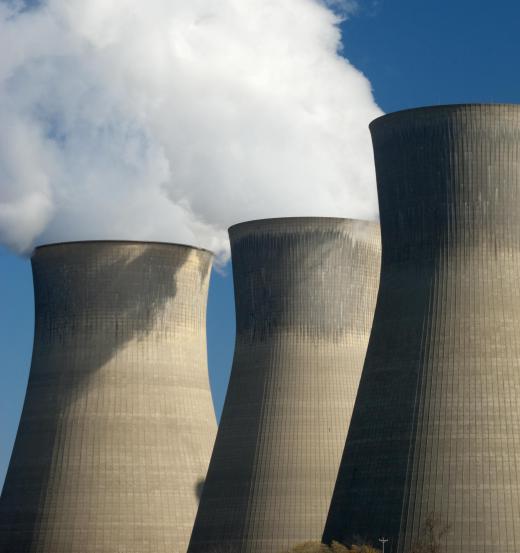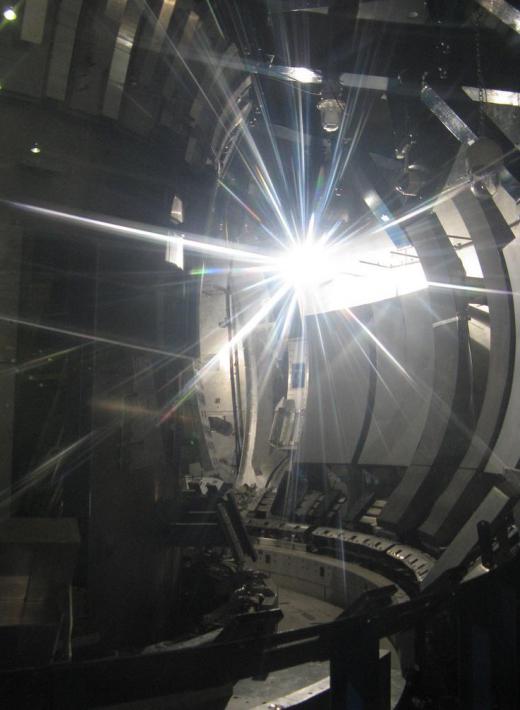What is Fusion Energy?
 Michael Anissimov
Michael Anissimov
Fusion energy is the extraction of energy from bonds between particles in the nuclei of atoms by fusing those nuclei together. To gain the most energy, light elements and isotopes like hydrogen, deuterium, tritium, and helium must be used, though every element with an atomic number lower than iron can produce net energy when fused. Fusion is in contrast to fission, the process whereby energy is generated by breaking apart heavy nuclei like uranium or plutonium. Both are considered to be nuclear energy, but fission is easier and better developed. All present-day nuclear power plants operate based on fission energy, but many scientists are hopeful that a power plant based on fusion energy will be developed before 2050.
There are nuclear bombs based on both fission energy and fusion energy. Conventional A-bombs are based on fission, while H-bombs, or hydrogen bombs, are based on fusion. Fusion more efficiently converts matter into energy, producing more heat and temperature when the process is channeled into a chain reaction. Thus H-bombs have higher yields than A-bombs, in some cases more than 5,000 times higher. H-bombs use a fission "booster" to attain the required temperature for nuclear fusion, which is approximately 20 million degrees Kelvin. In an H-bomb, approximately 1% of the reaction mass is converted directly into energy.

Fusion energy, not fission, is the energy that powers the Sun and produces all its heat and light. In the center of the Sun, approximately 4.26 million tonnes of hydrogen per second is converted into energy, producing 383 yottawatts (3.83×1026 W) or 9.15×1010 megatons of TNT per second. This sounds like a lot, but it's actually quite mild taking into account the total mass and volume of the Sun. The rate of energy production in the Sun's core is only about 0.3 W/m3 (watts per cubic meter), more than a million times weaker than the energy production that takes place in a light bulb filament. Only because the core is so huge, with a diameter equivalent to about 20 Earths, does it generate so much total energy.

For several decades, scientists have been working towards harnessing fusion energy for the needs of man, but this is difficult because of the high temperatures and pressures involved. Using fusion energy, a unit of fuel the size of a small ball bearing can produce as much energy as a barrel of gasoline. Unfortunately, all attempts at fusion power generation as of 2008 have consumed more energy than they have produced. There are two basic approaches -- use a magnetic field to compress a plasma to the critical temperature (magnetic confinement fusion), or fire lasers at a target so intense that they heat it past the critical threshold for fusion (inertial confinement fusion). Both these approaches have received significant funding, with the National Ignition Facility (NIF) trying for inertial confinement fusion and coming online in 2010, and the International Thermonuclear Experimental Reactor (ITER) trying for magnetic confinement fusion and coming online in 2018.
AS FEATURED ON:
AS FEATURED ON:













Discussion Comments
@Framemaker- Fusion energy reactors are actually not that far off from being functional. Fusion has some serious benefits to fissions, and fusion energy research has come a long way in the last decade. The hopes are to create a deuterium-deuterium reactor (deuterium is a hydrogen atom with one neutron versus tritium, which has two neutrons).
Deuterium-deuterium reactions produce more energy than current fusion technology, but require higher temperatures and pressure to produce. Deuterium is also easier to produce than tritium. Deuterium is easily found in seawater while tritium needs to be synthesized from lithium, a metal important to other industries like battery production. Additionally, deuterium is not radioactive, making it an appealing fuel source.
Fusion reactors may not be around yet, but they will likely be operational in the next few decades. There is a current international effort to build a fusion reactor in France for the purpose of producing energy.
Fission is essentially the splitting of the nucleus of a heavy atom into two lighter nuclei, producing energy in the process. For example, U-235 is a heavy atom that will spontaneously split into two smaller toms and two to three neutrons depending on how the atom splits. This spontaneous reaction creates large amounts of heat that can boil water to run a turbine.
Nuclear fusion energy occurs in the opposite way. In fusion, two hydrogen atoms (Deuterium and tritium) are forced together to form a helium-4 atom, a free neutron, and energy. The process requires very high heat and very high temperatures so that is why accelerated laser beams or nuclear fission starter reactions are used in fusion. For these reasons, the net energy output of fusion is less than the input.
What is the difference between fusion and fission energy? Can you have any other type of fusion besides from hydrogen energy? I do not quite understand the difference between the two types of reactions and why hydrogen is so vital.
Post your comments